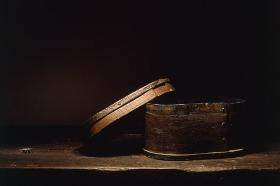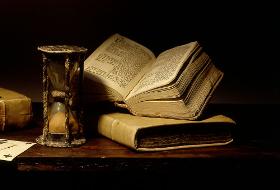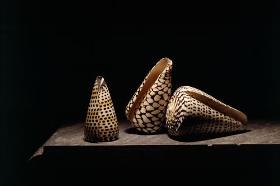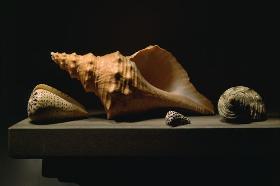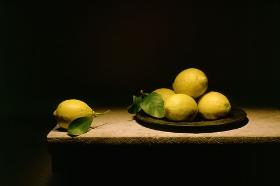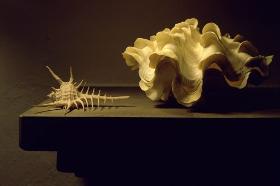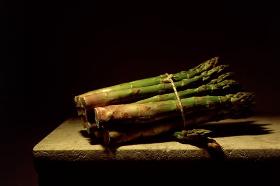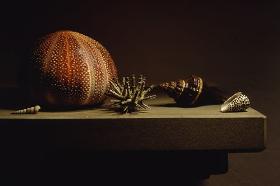| NATURE MORTE Still Life I once happened to look particularly carefully at certain photographs of shells. This put me in mind of my longstanding passion for shell collecting. Their natural fascination, their sense of balance, even in their obvious and total asymmetry, led me to rediscover that innermost world of things which I feel belong to beauty. As time passed, my desire to photograph "my shells" grew steadily, but I never felt ready to do so. During a visit to the rooms in the Louvre devoted to Flemish painting, I came upon a case with two tiny works on panel, one of which is shown here. They were of shells, and they had been painted by Adriaen Coorte, a seventeenth- century Dutch artist of whom I had never heard. Their intimate, delicate and photographic technique took me by surprise, and it was then, harnessing my hitherto unexpressed ambitions to the power of these still lifes, that I found a way to represent my own particular emotions. What emerged are these images, which gave form to my own hidden thoughts on the one hand, and which, on the other, are my attempt to pay homage to an extraordinary master of Dutch painting. Mauro Davoli |
|
|
|
...Whom is Davoli thinking of, when he arranges his shells, his walnuts and his kiwi fruit on an empty table? We want to come up with a name, indeed sometimes we feel that the name is there on the tip of our tongue. It may be Dutch or Flemish, or perhaps Spanish. But however hard we try, we cannot utter it. And our final impression is this: that Davoli has perfected the formal "hallmark" of a certain "genre", to the point that he can effortlessly "handle" it with other means; and that his is a cultured process, albeit practised with simplicity and artlessness, and hence without any concessions to the "postmodern". Still life is a "private" art form, conceived not for large spaces or grand rooms, but for domestic interiors, to be enjoyed at a leisurely pace, with plenty of pauses. These small alliances of objects invite us to
reflect on the diversity of both form (with one spiny "What happens to the rest?" This is the question which may arise, once we are faced with a certain kind of representation – the kind which presents just a few objects arranged on a table. And this question becomes more pressing if the objects include a book, an hourglass or a skull. For certain painters (think for example of Bartolomeo Bimbi), and during a certain period, the aim of artists painting still lifes had been the celebration of the profusion of nature; but as time passed, the character of the still life changed. The artist bid adieu to the splendours of abundance and excess; he began to restrict himself to painting a few objects– vestiges, as it were, of a world which was no more; and sensuality, however necessary to anyone intent on a faithful representation of form and matter, became tinged with melancholy. Still life became meditative, and meditation leads to thoughts of the last things; of death. This was the route to vanitas. People who go round with cameras, trying to capture images which are like museum paintings, are pursuing art through reality. Mario Davoli may be said to do almost the opposite: the gestures, the cautious and delicate moves with which he "prepares" his still lifes constitute – is this not the aim of every artist? – a search for reality through art. Once everything is in place, and shells and kiwi fruit and walnut and lemons and asparagus and skulls are there, on the bare primal table, all that remains to do is regulate the lighting so as to give the image a formal unity, and then – click – to press the shutter. The resulting photograph will look like a painting. Indeed, it will be one. Giovanni Mariotti from FMR June 2002 |
|
|
|
|
